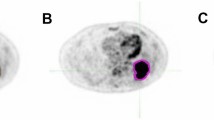Abstract
A computer-aided method was developed to automatically localize tumors in lung PET images of discrete bins within the breathing cycle, followed by an algorithm that registers all the information of a complete respiratory cycle into a single reference bin. Four registration/integration algorithms: Centroid Based, Intensity Based, Rigid Body, and Optical Flow registration were compared as well as two registration schemes: Direct scheme and Successive scheme. Validation was demonstrated by conducting experiments with the computerized 4D NCAT phantom and with a dynamic lung–chest phantom imaged using a GE PET/CT System. Iterations were conducted on different size simulated tumors. Static tumors without respiratory motion were used as gold standard; quantitative results were compared with respect to tumor activity concentration, cross-correlation coefficient, relative noise level, and computation time. After motion correction, the best compromise between short PET scan time and reduced image noise can be achieved, while quantification and clinical analysis become faster and more precise.









Similar content being viewed by others
References
Jemal A, Siegel R, Ward E, Hao Y, Xu J, Murray T, Thun MJ (2008) Cancer statistics, 2008. CA: A Cancer Journal for Clinicians 58:71–96
Yap CS, Czernin J, Fishbein MC, Cameron RB, Schiepers C, Phelps ME, Weber WA (2006) Evaluation of thoracic tumors with 18F-Fluorothymidine and 18F-Fluorodeoxyglucose-positron emission tomography. Am Coll Chest Phys 129:393–401
Nehmeh SA, Erdi YE, Ling CC, Rosenzweig KE, Squire OD, Braban LE, Ford E, Sidhu K, Mageras GS, Larson SM, Humm JL (2002) Effect of respiratory gating on reducing lung motion artifacts in PET imaging of lung cancer. Med Phys 29:366–371
Nehmeh SA, Erdi YE, Ling CC, Rosenzweig KE, Schoder H, Larson SM, Macapinlac HA, Squire OD, Humm JL (2002) Effect of respiratory gating on quantifying PET images of lung cancer. J Nucl Med 43:876–881
Nehmeh SA, Erdi YE, Rosenzweig KE, Schoder H, Larson SM, Squire OD, Humm JL (2003) Reduction of respiratory motion artifacts in PET imaging of lung cancer by respiratory correlated dynamic PET: methodology and comparison with respiratory gated PET. J Nucl Med 44:1644–1648
Wang Y, Baghaei H, Li H, Liu Y, Xing T, Uribe J, Ramirez R, Xie S, Kim S, Wong W-H (2005) A simple respiration gating technique and its application in high-resolution PET camera. IEEE Trans Nucl Sci 52:125–129
Goryawala M, del Valle M, Wang J, Byrne J, Franquiz J, McGoron AJ (2008) Low-cost respiratory motion tracking system, visualization, image-guided procedures, modeling. Proc SPIE Int Soc Opt Eng 6918:691822
Rahmim A (2005) Advanced motion correction methods in PET. Iran J Nucl Med 13:1–17
Nehmeh SA, Erdi YE (2008) Respiratory motion in positron emission tomography/computed tomography: a review. Semin Nucl Med 38:167–176
Visvikis D, Lamare F, Bruyant P, Boussion N, Cheze Le C (2006) Rest respiratory motion in positron emission tomography for oncology applications: problems and solutions. Nucl Instrum Methods Phys Res A 569:453–457
Qiao F, Clark J, Pan T, Mawlawi O (2005) Expectation maximization reconstruction of PET image with non-rigid motion compensation. Conf Proc IEEE Eng Med Biol Soc 4:4453–4456
Lamare F, Cresson T, Savean J, Cheze Le Rest C, Reader AJ, Visvikis D (2007) Respiratory motion correction for PET oncology applications using affine transformation of list mode data. Phys Med Biol 52:121–140
Livieratos L, Stegger L, Bloomfield PM, Schafers K, Bailey DL, Camici PG (2005) Rigid-body transformation of list-mode projection data for respiratory motion correction in cardiac PET. Phys Med Biol 50:3313–3322
El Naqa I, Low DA, Bradley JD, Vicic M, Deasy JO (2006) Deblurring of breathing motion artifacts in thoracic PET images by deconvolution methods. Med Phys 33:3587–3600
Dawood M, Lang N, Jiang X, Schafers KP (2006) Lung motion correction on respiratory gated 3-D PET/CT images. IEEE Trans Med Imaging 25:476–485
Thorndyke B, Schreibmann E, Koong A, Xing L (2006) Reducing respiratory motion artifacts in positron emission tomography through retrospective stacking. Med Phys 33:2632–2641
Qiao F, Pan T, Clark JW, Mawlawi OR (2007) Region of interest motion compensation for PET image reconstruction. Phys Med Biol 52:2675–2689
Laine AF, Schuler S, Fan J, Huda W (1994) Mammographic feature enhancement by multiscale analysis. IEEE Trans Med Imaging 13:725–740
Petrou M, Bosdogianni P (1999) Image processing: the fundamentals. Wiley, New York
Erdi YE, Mawlawi O, Larson SM, Imbriaco M, Yeung H, Finn R, Humm JL (1997) Segmentation of lung lesion volume by adaptive positron emission tomography image thresholding. Cancer 80:2505–2509
Horn BKP, Schunck BG (1981) Determining optical flow. Comput Vis 17:185–203
del Valle M, Goryawala M, McGoron AJ (2008) Dynamic lung tumor phantom coupled with chest motion, visualization, image-guided procedures, modeling. Proc SPIE Int Soc Opt Eng 6918:69182N
Segars WP, Tsui BM, Silva AJD (2002) CT-PET image fusion using the 4D NCAT phantom with the purpose of attenuation correction. IEEE Trans Nucl Sci 3:1775–1779
Segars WP, Lalush DS, Tsui BM (2001) Modeling respiratory mechanics in the MCAT and spline-based MCAT phantoms. IEEE Trans Nucl Sci 48:89–97
Segars WP (2001) Development of a new dynamic NURBS-based cardiac torso (NCAT) phantom. PhD Dissertation, The University of North Carolina
Razifar P, Lubberink M, Schneider H, Langstrom B, Bengtsson E, Bergstrom M (2005) Non-isotropic noise correlation in PET data reconstructed by FBP but not by OSEM demonstrated using auto-correlation function. BMC Med Imaging 5:3
Acknowledgments
This study is supported in part by research grant from the National Institutes of Health (NIH R15CA118284-01) and FIU University Dissertation Year Fellowship.
Author information
Authors and Affiliations
Corresponding author
Rights and permissions
About this article
Cite this article
Wang, J., del Valle, M., Goryawala, M. et al. Computer-assisted quantification of lung tumors in respiratory gated PET/CT images: phantom study. Med Biol Eng Comput 48, 49–58 (2010). https://doi.org/10.1007/s11517-009-0549-6
Received:
Accepted:
Published:
Issue Date:
DOI: https://doi.org/10.1007/s11517-009-0549-6




